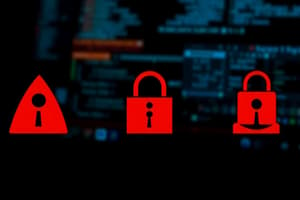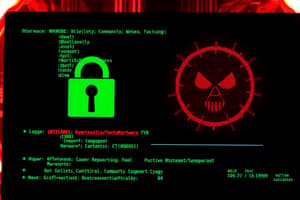Podcast
Questions and Answers
What does the term 'malware' refer to?
What does the term 'malware' refer to?
- Hardware damage
- Network configuration
- Internet speed issues
- Malicious software (correct)
How does a computer virus typically infect another computer?
How does a computer virus typically infect another computer?
- Via system updates
- By attaching itself to documents or software (correct)
- By accessing the internet directly
- Through direct network connections
What is a characteristic of a Trojan horse?
What is a characteristic of a Trojan horse?
- It behaves like a useful program but contains malicious code (correct)
- It replicates itself to other systems
- It deletes files on the computer
- It can only be installed through USB drives
What is the primary function of worms in malware?
What is the primary function of worms in malware?
What should individuals regularly do to protect their computers from malware?
What should individuals regularly do to protect their computers from malware?
What is the main goal of phishing attacks?
What is the main goal of phishing attacks?
Which type of malware is designed to replicate and spread automatically?
Which type of malware is designed to replicate and spread automatically?
Why do organizations often have written security policies regarding software installation?
Why do organizations often have written security policies regarding software installation?
What are smart watches designed to combine?
What are smart watches designed to combine?
Which feature is common in most smart watches?
Which feature is common in most smart watches?
What is the primary purpose of fitness monitors?
What is the primary purpose of fitness monitors?
How do smart headsets primarily connect to the internet?
How do smart headsets primarily connect to the internet?
What type of devices are considered wearable devices?
What type of devices are considered wearable devices?
What is a unique feature of smart headsets?
What is a unique feature of smart headsets?
Which statement is true about the functionality of laptops and mobile devices?
Which statement is true about the functionality of laptops and mobile devices?
Which of the following can fitness monitors do?
Which of the following can fitness monitors do?
What is the primary function of antivirus protection?
What is the primary function of antivirus protection?
Which type of protection warns users about unsafe programs before they are installed?
Which type of protection warns users about unsafe programs before they are installed?
What action should you take when encountering a suspicious warning window?
What action should you take when encountering a suspicious warning window?
Why is it recommended to run only one malware protection program at a time?
Why is it recommended to run only one malware protection program at a time?
What is the role of phishing protection software?
What is the role of phishing protection software?
What might a rogue antivirus product do to trick users?
What might a rogue antivirus product do to trick users?
What is a common method to handle a persistent malicious warning window?
What is a common method to handle a persistent malicious warning window?
What type of software actively searches for programs that display advertisements?
What type of software actively searches for programs that display advertisements?
What action is used to zoom in on objects on a mobile device?
What action is used to zoom in on objects on a mobile device?
What is the purpose of a proximity sensor in a smartphone?
What is the purpose of a proximity sensor in a smartphone?
What feature distinguishes laptops from desktop computers?
What feature distinguishes laptops from desktop computers?
Which of the following is NOT a common input device found in laptops?
Which of the following is NOT a common input device found in laptops?
Which of the following describes accessories for mobile devices?
Which of the following describes accessories for mobile devices?
What kind of power source do laptops use?
What kind of power source do laptops use?
What can protective covers for mobile devices protect against?
What can protective covers for mobile devices protect against?
What is the primary function of external batteries or portable chargers?
What is the primary function of external batteries or portable chargers?
Where are the LEDs indicating device status commonly located on a laptop?
Where are the LEDs indicating device status commonly located on a laptop?
What is a defining characteristic of mobile devices compared to laptops?
What is a defining characteristic of mobile devices compared to laptops?
What feature do most docking stations have?
What feature do most docking stations have?
How does the CPU architecture of mobile devices differ from that of laptops?
How does the CPU architecture of mobile devices differ from that of laptops?
What is a primary benefit of using headsets or ear buds?
What is a primary benefit of using headsets or ear buds?
Which of the following accessories can be used for processing credit card payments?
Which of the following accessories can be used for processing credit card payments?
Which of the following is a built-in input device typically found on laptops?
Which of the following is a built-in input device typically found on laptops?
What is the primary reason for the increasing popularity of laptops and mobile devices?
What is the primary reason for the increasing popularity of laptops and mobile devices?
What is spear phishing?
What is spear phishing?
What is a primary characteristic of spam?
What is a primary characteristic of spam?
Why are organizations encouraged to educate users about phishing?
Why are organizations encouraged to educate users about phishing?
What should a user do if they are unsure about a request for personal information?
What should a user do if they are unsure about a request for personal information?
What usually causes the bulk sending of spam emails?
What usually causes the bulk sending of spam emails?
What is an effective measure against spam?
What is an effective measure against spam?
What does social engineering involve?
What does social engineering involve?
What is a common misconception about email attachments?
What is a common misconception about email attachments?
Flashcards
Laptop
Laptop
A compact, portable computer with built-in features like keyboard, touchpad, and webcam.
Laptop power adapter
Laptop power adapter
An external power source for laptops, allowing them to run without needing a power outlet. It plugs into the laptop's power port.
Touchpad
Touchpad
A small, sensitive surface on a laptop that controls the cursor on the screen. It uses multi-touch gestures for navigation and commands.
Pointing stick
Pointing stick
Signup and view all the flashcards
LEDs in laptops
LEDs in laptops
Signup and view all the flashcards
Mobile device
Mobile device
Signup and view all the flashcards
Mobile device operating system
Mobile device operating system
Signup and view all the flashcards
Mobile device CPU architecture
Mobile device CPU architecture
Signup and view all the flashcards
What are game pads?
What are game pads?
Signup and view all the flashcards
What are wearable devices?
What are wearable devices?
Signup and view all the flashcards
What are smart watches?
What are smart watches?
Signup and view all the flashcards
What are fitness monitors?
What are fitness monitors?
Signup and view all the flashcards
What are smart headsets?
What are smart headsets?
Signup and view all the flashcards
What is a key characteristic of laptops and mobile devices?
What is a key characteristic of laptops and mobile devices?
Signup and view all the flashcards
How do mobile devices increase storage?
How do mobile devices increase storage?
Signup and view all the flashcards
What is an example of a category of mobile devices?
What is an example of a category of mobile devices?
Signup and view all the flashcards
Spread Zoom
Spread Zoom
Signup and view all the flashcards
Proximity Sensor
Proximity Sensor
Signup and view all the flashcards
Mobile Device Accessories
Mobile Device Accessories
Signup and view all the flashcards
Protective Covers for Mobile Devices
Protective Covers for Mobile Devices
Signup and view all the flashcards
External Batteries/Portable Chargers
External Batteries/Portable Chargers
Signup and view all the flashcards
Docking Stations
Docking Stations
Signup and view all the flashcards
Headsets/Ear Buds
Headsets/Ear Buds
Signup and view all the flashcards
Speakers for Mobile Devices
Speakers for Mobile Devices
Signup and view all the flashcards
Phishing
Phishing
Signup and view all the flashcards
Spear Phishing
Spear Phishing
Signup and view all the flashcards
Spam
Spam
Signup and view all the flashcards
Social Engineering
Social Engineering
Signup and view all the flashcards
Worm
Worm
Signup and view all the flashcards
Virus
Virus
Signup and view all the flashcards
Antivirus Software
Antivirus Software
Signup and view all the flashcards
Email Filtering
Email Filtering
Signup and view all the flashcards
Antivirus Protection
Antivirus Protection
Signup and view all the flashcards
Adware Protection
Adware Protection
Signup and view all the flashcards
Phishing Protection
Phishing Protection
Signup and view all the flashcards
Spyware Protection
Spyware Protection
Signup and view all the flashcards
Trusted/Untrusted Source Protection
Trusted/Untrusted Source Protection
Signup and view all the flashcards
Rogue Antivirus
Rogue Antivirus
Signup and view all the flashcards
Computer Security
Computer Security
Signup and view all the flashcards
Malware
Malware
Signup and view all the flashcards
Trojan Horse
Trojan Horse
Signup and view all the flashcards
Computer Virus
Computer Virus
Signup and view all the flashcards
Browser Redirection
Browser Redirection
Signup and view all the flashcards
Security Policy
Security Policy
Signup and view all the flashcards
Study Notes
Chapter 12: Security
- This chapter reviews types of attacks threatening computer security.
- Technicians are responsible for data and equipment security.
- Understanding physical and data threats is crucial for protection.
- Physical threats involve stealing, damaging, or destroying equipment (e.g., servers, wiring).
- Data threats involve removing, corrupting, denying access, or stealing information.
Types of Security Threats
- Malware: software designed for malicious activities.
- Malware is often installed without user knowledge and can change computer configurations or redirect web browsers.
- Malware can collect information without consent.
- Virus: a form of malware that spreads via files, transfers, emails, and instant messages.
- Worm: self-replicating malware damaging networks.
- Trojan horse: malware disguised as a useful program.
Phishing
- Phishing involves deceitful emails, calls, or texts to trick users into providing personal or financial information.
- Attackers often impersonate legitimate organizations like banks.
Spam
- Unsolicited email often used for advertising, harmful links, or malware distribution.
- Spam is filtered by ISPs and antivirus software.
- Opening suspicious attachments can spread malware.
Social Engineering
- Attackers manipulate individuals to gain access to networks or equipment.
- Employees should be cautious and verify requests before divulging information.
- Precautions include not giving out login details, securing computer areas, and verifying the identity of visitors.
Security Procedures
- Security policy: a set of objectives ensuring network, data, and system security.
- Security policies are dynamic, adapting to changing technologies, businesses, and employee needs.
- Security policy is usually created and managed by organizational management and the IT staff.
- Usernames and passwords: should adhere to a standard naming convention.
- Passwords are crucial for security and should not be revealed.
Protection Against Malicious Software
- Malware protection programs: include antivirus, anti-spyware, and anti-adware software.
- Regularly updating malware protection software is essential.
- Malware programs continuously monitor for malware.
- Running multiple malware protection programs simultaneously is discouraged.
- Rogue antivirus programs are malicious software disguised as security tools. Be cautious about downloading and installing unverified programs.
- Organizations should scan for threats regularly to ensure systems are secure.
Summary
- Security threats can come from inside or outside the organization.
- Viruses, worms, and Trojans can compromise data or physical equipment.
- Develop security plans to protect data and physical equipment.
- Keep operating systems and applications up-to-date.
Studying That Suits You
Use AI to generate personalized quizzes and flashcards to suit your learning preferences.




